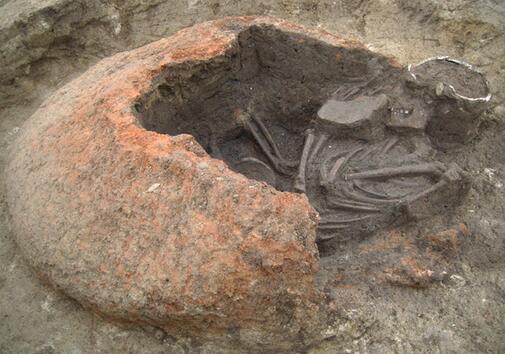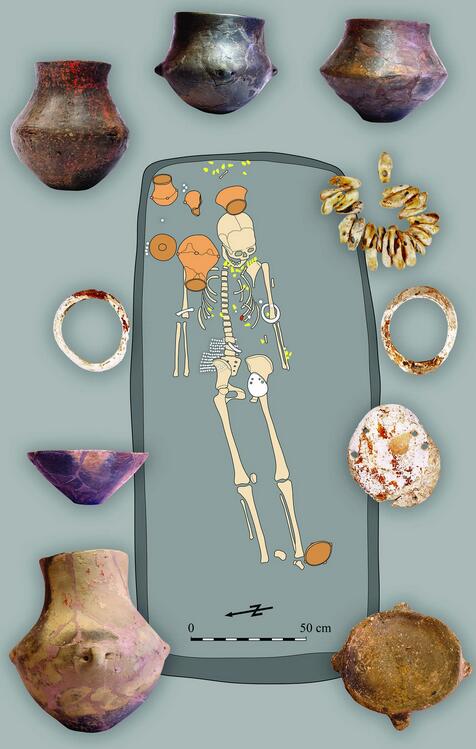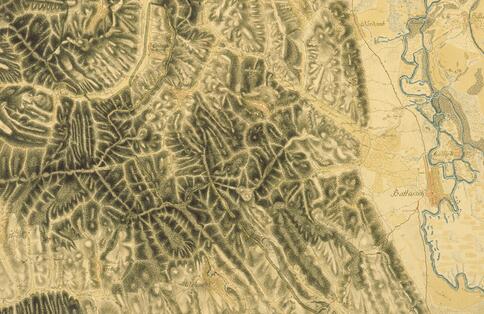The Neolithic at Alsónyék in southern Hungary: a persistent place for 1300 years in the 6.-5. millennia BC (Excavation and proceedings)
From:Shanghai Archaeology Forum NetWriter:Date:2017-12-14
About the discovery and the long Neolithic sequenceThe site of Alsónyék lies in south-west Hungary, in between the Danube and the forested hills of Transdanubia, in a muddy alluvial landscape called Sárköz. It was discovered and excavated prior to motorway constructions, between 2006 and 2009. Parts of the site were excavated by different teams, but the main area and major parts of the ongoing evaluation became concentrated in the Institute of Archaeology Research Centre for the Humanities, Hungarian Academy of Sciences, Budapest.
This Neolithic settlement and cemetery is proved to be surprising and remarkable both in temporal and in spatial terms. First, it has a very long sequence of occupation, from the Early to the Late Neolithic, broadly from ca. 5750 cal BC to ca. 4300 cal BC. That encompasses the settlement of the first farmers arriving from the Balkans, one of the central European Linearbandkeramik culture (LBK), then settlements and cemeteries of the Sopot and Lengyel periods, which all spread horizontally over wide areas of the site, without formation of deep stratigraphy. Such persistence of place without tell formation is, on the basis of present knowledge, unprecedented in the Hungarian Neolithic. Secondly, the Lengyel occupation, including houses, pits and graves, is of unparalleled size. The large excavated surface was completed by extended geomagnetic prospections and thus the full size can be estimated to reaching a possible extent of some 80 hectares. With this size, the Alsónyék is perhaps larger than other known Neolithic sites in Hungary by a factor of at least two or three, and makes the site match the “megasites” of the chalcolithic Tripolje-culture in East Europe.

From its earliest phase, at the beginning of the 6th millennium, many early Neolithic, “Starčevo” features were excavated. The most common features are the large irregular pits and the pit complexes, in which traces of many ovens were found including ca. 15 ovens and ca. 50 pits, mostly large pit complexes. Twenty-five Starčevo burials provide the first opportunity in Hungary to investigate the burial customs, origin, diet, lifestyle and other aspects of Starčevo people through various kinds of bioarchaeological research. Some of the skeletons were squeezed in subterranean ovens dug into the side walls of pits.
The only small gap in between the settlement phases was detected after the Starčevo and the oldest Central European Neolithic group, that of the Bandkeramik (LBK). Although the migrants from the Balkan i.e. the Starčevo people played an essential role in the formation of the LBK, this process happened north to Alsónyék. It took some generations until the early LBK groups reached the Sárköz wetland region and settled many places around, also at Alsónyék.
There must be some overlap in the settling of the late LBK occupants and the people of the Sopot culture, again arriving from the northern Balkans. At the eastern edge of the site some ten large, pit complexes (2–7 m in diameter) and small sections of four more or less parallel ditches were investigated, and also a well was unearthed. There is again geophysical evidence, for a greater extent to the Sopot occupation, in spite of the relatively few features investigated. A very rich and important assemblage of Sopot material, including eighteen Sopot graves, two of them double burials, are particularly significant. Most of the deceased were buried in a crouched position, but the skeletons were of tall and robust people, compared to the local Neolithic population. Many of these burials contained pots, and Spondylus ornaments and chipped and polished stone artefacts were also found. This group of Sopot graves is the largest ever discovered in Hungary, and various bioarchaeological studies will follow in due course. The ditch system is also an important discovery.
The Neolithic settlement of Alsónyék reached its greatest extent during the Late Neolithic Lengyel period. Nearly 9000 features, including postholes associated with 122 houses, pits and pit complexes, and approximately 2300 burials, could be assigned to it. The traces of Lengyel settlement and burials were found over the entire excavated area, with an estimated extent of the already mentioned 80 ha.

The 122 surface-level, robust timber-framed houses at a single site is unprecedented for the area and the period. Many more could be detected with the help of geophysical prospections. These buildings help provide a better understanding of the architecture and lifestyle of the Lengyel population.
The numbers of burials and the special arrangements for the deceased over the late Neolithic are what makes the Alsónyék site exceptionally significant. Compared to other significant late Neolithic site of the Lengyel culture with some dozen or a hundred burials known, the ca. 2350 burials uncovered is unique in the European early farming records. The burials mostly form grave groups, constituting small nuclear cemeteries within the various parts of the settlement. Ninety-two distinct burial groups were found, ranging over the whole site. The smallest of these contain 25–30 burials, and the largest ca. 100. Apart from the grave groups, several solitary or scattered graves were also found; some of these were inserted into pits, others were on the location of former houses and some were even arranged in small clusters, but the enormous number of graves at Alsónyék and the abundant grave goods provide an unprecedented opportunity for osteological, palaeopathological and demographic investigations, and for archaeological analysis of mortuary practices and social differentiation, as well as of the long-distance networks and exchange activity reflected in grave goods.
Proceeding the new information: a wide range of archaeological and hard scientific investigations
This work has required the ongoing cooperation of an extended research group. Eszter Bánffy leads this team, and is responsible for the analysis of the Starčevo occupation with Tibor Marton and Anett Osztás, whilst Krisztián Oross and Tibor Marton are working on the LBK and Sopot periods. Anett Osztás is writing up the Lengyel house architecture and settlement structure for her PhD thesis. Krisztina Somogyi (ÁSATÁRS Cultural, Archaeological Servicing and Commercial Ltd.), who was one of the excavators of the site, is carrying out the processing of pottery connected to certain house groups of the Lengyel settlement in her PhD thesis. István Zalai-Gaál (who passed away sadly this year) was involved in evaluating all the graves and most of the grave goods, including their typology, relative chronology and connections with neighbouring groups, not to mention their social archaeological dimensions. All this research has been underpinned by a grant from OTKA (K 81230), the Hungarian Scientific Fund, for the primary documentation and evaluation of the finds.
Bioarchaeological investigations are also underway. The osteology and the palaeopathology of the nearly 2500 human remains are the task of Kitti Köhler (Institute of Archaeology, Research Centre for the Humanities, Hungarian Academy of Sciences); 862 Lengyel graves were the subject of her PhD dissertation. These unique anthropological assemblages have become cornerstones in several international collaborations. Run together with the Anthropology Department of Mainz University, a major aDNA and stable isotope sampling between 2009 and 2013 was supported by the Deutsche Forschungsgemeinschaft (led by Kurt W. Alt and Eszter Bánffy). Anna Szécsenyi-Nagy (Institute of Archaeology, Research Centre for the Humanities, Hungarian Academy of Sciences) successfully investigated 68 mitochondrial DNA samples from all periods of Alsónyék except the LBK. In her PhD she has analysed a couple of hundred mtDNA samples from Transdanubian contexts (Szécsényi-Nagy 2015). The first results regarding the genetic origin of Europe’s first farmers have already published (Szécsényi-Nagy et al. 2015). The investigation goes on, with new generation (autosomal) aDNA, with the participation of David Reich (Harvard Medical School) and Johannes Krause, Wolfgang Haak (Max Planck Institute for the Science of Human History, Jena). Parallel to this, Alex Mörseburg (Institute of Anthropology, Johannes Gutenberg University of Mainz) is evaluating the stable isotope results from both human and animal samples.
The new research will answer some of the questions on dietary habits and their changes, about mobility, migrations and also, about pathological issues including epidemics. This is a continuation of some surprising results of earlier osteological and microbiological analyses. Discovery of the presence of tuberculosis at Alsónyék within the Lengyel population presents one of the oldest cases so far of this disease in Europe. Kitti Köhler has clearly identified tuberculosis for the first time, within grave group 13, on the basis of physical anthropological alterations. The palaeopathological analysis of this grave group has been supplemented with the help of Erika Molnár and György Pálfi (Department of Biological Anthropology, University of Szeged). All the individuals of this grave group were subsequently subjected to palaeomicrobiological analysis (Institute for Mummies and the Iceman, EURAC Research, Bolzano) with the help of Annamária Pósa (Institute of Archaeology, Research Centre for the Humanities, Hungarian Academy of Sciences). Balázs G. Mende (Institute of Archaeology, Research Centre for the Humanities, Hungarian Academy of Sciences) is dealing with the general impact of the disease for the Lengyel community.

One of the biogeochemical projects has just begun. A major DFG-funded project at Heidelberg University, which is concentrating on early Neolithic milk consumption and dietary change in south-east Europe, is analysing the Starčevo pottery and stone tools from Alsónyék (Food cultures: interdisciplinary studies of early farming food technology and palaeodiet in southeastern Europe: led by Maria Ivanova-Bieg). Associated with this, Angela Kreuz (Archäologische und Paläontologische Denkmalpflege, Landesamt für Denkmalpflege Hessen) is studying the Starčevo botanical remains. Éva Ágnes Nyerges (Institute of Archaeology, Research Centre for the Humanities, Hungarian Academy of Sciences) is studying the extensive zooarchaeological remains from Alsónyék for her PhD, focusing especially on changes in agriculture through the Neolithic period. Kata Szilágyi (Móra Ferenc Museum, Szeged) is studying the rich Late Neolithic chipped stone material in her PhD dissertation, from both the technological and the raw material point of view. Pál Sümegi and his colleagues (Department of Geology and Palaeontology, University of Szeged) are responsible for palaeoenvironmental reconstruction including analysis of mollusca as well as the investigation of the shell ornaments (Spondylus and Dentalium). A major cooperation with the Times of Their Lives ERC project helped to create the fine absolute chronological sequence, interpreted in a formal Bayesian statistical framework, the two PIs are Alasdair Whittle (Univesrity of Cardiff) and Alex Bayliss (Historic England), concentrate on the radiocarbon chronology of Alsónyék. There is cooperation with the Römisch-Germanische Kommission of the German Archaeological Institute (Frankfurt am Main) under the leadership of Eszter Bánffy, which in addition to other Neolithic sites in the Sárköz area is concentrating on the geomagnetic survey of the unexplored areas of Alsónyék, in order to make estimates of the size and the spatial organisation of the Neolithic settlements.
And last but not least, the newly established Research Station of the Römisch-Germanische Kommission in Budapest enables Eszter Bánffy to both supply the proceedings with financial support and also, to tutor the PhD students, to fasten together and lead all the large-scale and diversified research that has grown out of the Alsónyék site and around of the Sárköz Neolithic.
Several studies discussing the site and its finds have already been published, ranging from preliminary reports (Bánffy et al. 2010; Gallina et al. 2010; Gelencsér 2010; Majerik et al. 2010) to articles devoted to particular aspects (Zalai-Gaál 2008; 2013; Zalai-Gaál / Osztás 2009a; 2009b; Zalai-Gaál et al. 2009; 2010; 2011a; 2011b; 2012a; 2012b; 2014a; 2014b; Osztás et al. 2012; Köhler 2012; 2013; Köhler et al. 2013; 2014; Nyerges 2013; Somogyi / Gallina 2013; Serlegi et al. 2013; Szécsényi-nagy et al. 2015; Rassmann et al. 2015; Pósa et al. 2015). A thematic volume was devoted to the precise chronology of the site was published in 2016, with the participation of Alasdair Whittle, Alex Bayliss and the whole British-Hungarian team (Bericht der Römisch-Germansichen Komission 94, 2016: 1-361). The latest article, published in Nature, about the parallel investigation of the spread of farming and the interaction between local hunter-gatherers and newcomers was largely based on the aDNA analysis of the Alsónyék skeletons and on the earlier bioarchaeological project by Kurt Alt, Eszter Bánffy and Anna Szécsényi-Nagy: Lipson et al 2017). The ongoing investigations of the Alsónyék site and its finds will last for a few more years.

